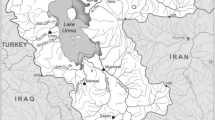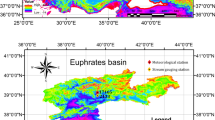Abstract
Undoubtedly, the most significant factor with wise decision making and designing hydrological structures along the lake coasts is an accurate model of lake level changes. This issue becomes more and more important as recent global climate changes have completely reformed the behavior of traditional lake level fluctuations. Subsequently, estimating lake levels becomes more important and at the same time more difficult. This paper deals with modeling lake level changes of Lake Urmia located in north-west of Iran, in terms of both simulator and predictor models. According to this, two traditional simulator models based on water budget are developed which benefit from most effective components on water budget namely precipitation, evaporation, inflow and the lake level antecedents, as model inputs. Most famous linear modeling tools, Autoregressive with exogenous input (ARX) and Box-Jenkins (BJ) models are employed with the same mentioned inputs for prediction purpose. In addition, two other methods that are, Multi-Layer Perceptron (MLP) neural network and also Local Linear Neuro-Fuzzy (LLNF) are applied to investigate capability of intelligent nonlinear methods for lake level changes prediction. All models performances are indicated using both graph and numerical illustrations and results are discussed. Comparative results reveal that the intelligent methods are superior to traditional models for modeling lake level behavior as complex hydrological phenomena.















Similar content being viewed by others
References
Afshar A, Mariño MA, Saadatpour M, Afshar A (2011) Fuzzy TOPSIS multi-criteria decision analysis applied to Karun reservoirs system. Water Resour Manag 25(2):545–563
Altunkaynak A (2007) Forecasting surface water level fluctuations of Lake Van by artificial neural networks. Water Resour Manag 21(2):399–408
Astushi U, Masaki T, Yoshio I (2004) Lake-level changes during the past 100,000 years at Lake Baikal, southern Siberia. Quat Res 62(2):214–222
Aytek A, Alp M (2008) An application of artificial intelligence for rainfall runoff modeling. J Earth Syst Sci 117(2):145–155
Babovic V, Keijzer M (2002) Rainfall runoff modelling based on genetic programming. Nord Hydrol 33(5):331–346
Banadaki DH, Nozari HA, Kakahaji H (2011) Nonlinear simulator model identification of a walking beam furnace using recurrent local linear neuro-fuzzy network. Int J Control Autom 4(4):123–134
Bengtsson L, Malm J (1997) Using rainfall–runoff modeling to interpret lake level data. J Paleolimnol 18(3):235–248
Billings SA, Voon WSF (1986) Correlation based model validity tests for non-linear models. Int J Control 44(1):235–244
Billings SA, Voon WSF (1987) Piecewise linear identification of non-linear systems. Int J control 46(1):215–235
Chatterjee S, Hadi AS (1986) Influential observations, high leverage points, and outliers in linear regression. Stat Sci 1(3):379–416
Cybenko G (1989) Approximation by superposition of a sigmoidal function. Math Control Signals Syst 2(4):303–314
Ghorbani MA, Khatibi R, Aytek A, Makarynskyy O, Shiri J (2010) Sea water level forecasting using genetic programming and comparing the performance with Artificial Neural Networks. Comput Geosci 36(5):620–627
Güldal V, Tongal H (2010) Comparison of recurrent neural network, adaptive neuro-fuzzy inference system and stochastic models in Eğirdir lake level forecasting. Water Resour Manag 24(1):105–128
Hagan MT, Menhaj MB (1994) Training feedforward networks with the Marquardt algorithm. IEEE Trans Neural Netw 5(6):989–993
Hassanzadeh E, Zarghami M, Hassanzadeh Y (2012) Determining the main factors in declining the Urmia lake level by using system dynamics modeling. Water Resour Manag 26(1):129–145
Haykin S (1999) Neural networks: a comprehensive foundation, 2nd Ed. Prentice Hall PTR Upper Saddle River, NJ, USA
Hornik K, Stinchcombe M, White H (1989) Multilayer feedforward networks are universal approximators. Neural Netw 2(5):359–366
Iranian Ministry of Energy (2007) Water allocation for the development projects in Urmia Lake basin, technical report of Water and Wastewater Planning Office
Iranian Society of Consulting Engineers (2011) Environmental crisis of Lake Urmia. J Consult Eng 53:30–52
Jones RN, McMahon TA, Bowler JM (2001) Modelling historical lake levels and recent climate change at three closed lakes, Western Victoria, Australia (c. 1840–1990). J Hydrol 246(1–4):159–180
Kadıoğlu M, Sen Z, Batur F (1999) Cumulative departures model for lake-water fluctuations. J Hydrol Eng 4(3):245–250
Karimi S, Shiri J, Kisi O, Makarynskyy O (2012) Forecasting water level fluctuations of Urmieh lake using gene expression programming and adaptive neuro-fuzzy inference system. Int J Ocean Clim Syst 3(2):109–126
Karimi S, Kisi O, Shiri J, Makarynskyy O (2013) Neuro-fuzzy and neural network techniques for forecasting sea level in Darwin Harbor, Australia. Comput Geosci 52:50–59
Kavehkar SH, Ghorbani MA, Khokhlov V, Ashrafzadeh A, Darbandi S (2011) Exploiting two intelligent models to predict water level: a field study of Urmia lake, Iran. Int J Civ Environ Eng 3(3):162–166
Khu ST, Liong SY, Babovic V, Madsen H, Muttil N (2001) Genetic programming and its application in real-time runoff forecasting. J Am Water Resour Assoc 37(2):439–451
Kisi O, Shiri J, Nikoofar B (2012) Forecasting daily lake levels using artificial intelligence approaches. Comput Geosci 41:169–180
Liong SY, Gautam TR, Khu ST, Babovic V, Keijzer M, Muttil N (2002) Genetic programming: a new paradigm in rainfall runoff modeling. J Am Water Resour Assoc 38(3):705–718
Ljung L (1987) System identification theory for the user. Prentice Hall, Upper Saddle River
Marce R, Comerma M, Garcia JC, Armengol J (2004) A neuro-fuzzy modeling tool to estimate fluvial nutrient loads in watersheds under time-varying human impact. Limnol Oceanogr Methods 2:342–355
Muttil N, Liong SY (2001) Improving runoff forecasting by input variable selection in GP. In Proceedings of the World Water and Environmental Resources Congress, pp. 1−7 Orlando, Florida, USA
Nelles O (2001) Nonlinear system identification: from classical approaches to neural networks and fuzzy models. Springer, Berlin
Nelles O, Isermann R (1996) Basis function networks for interpolation of local linear models. In Proceedings of the 35th IEEE Conference on Decision and Control, pp. 470–475 Kobe, Japan
Nozari HA, Banadaki HD, Mokhtare M, Vahed SH (2012a) Intelligent non-linear modelling of an industrial winding process using recurrent local linear neuro-fuzzy networks. J Zhejiang Univ Sci C 13(6):403–412
Nozari HA, Simani S, Shoorehdeli MA, Banadaki DH (2012b) Model-based robust fault detection and isolation of an industrial gas turbine prototype using soft computing techniques. Neurocomputing 91(15):29–47
Ostadrahimi L, Mariño MA, Afshar A (2012) Multi-reservoir operation rules: multi-swarm PSO-based optimization approach. Water Resour Manag 26(2):407–427
Roshan G, Ghanghermeh AA, Nasrabadi T, Meimandi JB (2013) Effect of global warming on intensity and frequency curves of precipitation, case study of Northwestern Iran. Water Resour Manag 27(5):1563–1579
Sang YF (2013) Improved wavelet modeling framework for hydrologic time series forecasting. Water Resour Manag 27(8):2807–2821
Shiri J, Makarynskyy O, Kisi O, Dierickx W, Fard A (2011) Prediction of short-term operational water levels using an adaptive neuro-fuzzy inference system. J Waterw Port Coast Ocean Eng 137(6):344–354
Tabari H, Nikbakht J, Talaee PH (2013) Hydrological drought assessment in Northwestern Iran based on Streamflow Drought Index (SDI). Water Resour Manag 27(1):137–151
Talebizadeh M, Moridnejad A (2011) Uncertainty analysis for the forecast of lake level fluctuations using ensembles of ANN and ANFIS models. Expert Syst Appl 38(4):4126–4135
Vaziri M (1997) Predicting Caspian Sea surface water level by ANN and ARIMA models. Waterw Port Coast Ocean Eng 123(4):158–162
Water Resources Management Company of Iran (2011) Status of water supply installation of Urmia Lake’s watershed, technical report (in Persian)
Acknowledgments
First author would like to thank Ms. Mina Ghanavati for her help and feedback. The authors express their thanks to Dr. Mahdi Aliyari Shooredeli for his scientific recommendations. We also sincerely appreciate Dr. Ellips Masehian for his valuable guidance.
Author information
Authors and Affiliations
Corresponding author
Rights and permissions
About this article
Cite this article
Kakahaji, H., Banadaki, H.D., Kakahaji, A. et al. Prediction of Urmia Lake Water-Level Fluctuations by Using Analytical, Linear Statistic and Intelligent Methods. Water Resour Manage 27, 4469–4492 (2013). https://doi.org/10.1007/s11269-013-0420-2
Received:
Accepted:
Published:
Issue Date:
DOI: https://doi.org/10.1007/s11269-013-0420-2




